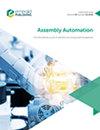Knowledge-enabled digital twin for smart designing of aircraft assembly line
IF 1.9
4区 计算机科学
Q3 AUTOMATION & CONTROL SYSTEMS
引用次数: 5
Abstract
Purpose The purpose of this paper is to provide a knowledge-enabled digital twin for smart design (KDT-SD) of aircraft assembly line (AAL) to enhance the AAL efficiency, performance and visibility. Modern AALs usually need to have capabilities such as digital-physical interaction and self-evaluation that brings significant challenges to traditional design method for AAL. The digital twin (DT) combining with reusable knowledge, as the key technologies in this framework, is introduced to promote the design process by configuring, understanding and evaluating design scheme. Design/methodology/approach The proposed KDT-SD framework is designed with the introduction of DT and knowledge. First, dynamic design knowledge library (DDK-Lib) is established which could support the various activities of DT in the entire design process. Then, the knowledge-driven digital AAL modeling method is proposed. At last, knowledge-based smart evaluation is used to understand and identify the design flaws, which could further improvement of the design scheme. Findings By means of the KDT-SD framework proposed, it is possible to apply DT to reduce the complexity and discover design flaws in AAL design. Moreover, the knowledge equips DT with the capacities of rapid modeling and smart evaluation that improve design efficiency and quality. Originality/value The proposed KDT-SD framework can provide efficient design of AAL and evaluate the design performance in advance so that the feasibility of design scheme can be improved as much as possible.基于知识的飞机装配线智能设计数字孪生
目的本文旨在为飞机装配线(AAL)的智能设计(KDT-SD)提供一个知识赋能的数字孪生,以提高AAL的效率、性能和可见性。现代AAL通常需要具备数字物理交互和自我评价等能力,这给传统的AAL设计方法带来了重大挑战。数字孪生(DT)与可重用知识相结合,作为该框架中的关键技术,通过配置、理解和评估设计方案来促进设计过程。设计/方法论/方法所提出的KDT-SD框架是在引入DT和知识的情况下设计的。首先,建立了动态设计知识库(DDK-Lib),可以支持DT在整个设计过程中的各种活动。然后,提出了知识驱动的数字AAL建模方法。最后,运用基于知识的智能评价方法来理解和识别设计缺陷,从而进一步完善设计方案。发现通过提出的KDT-SD框架,可以应用DT来降低AAL设计的复杂性并发现设计缺陷。此外,这些知识使DT具备了快速建模和智能评估的能力,从而提高了设计效率和质量。独创性/价值所提出的KDT-SD框架可以提供高效的AAL设计,并提前评估设计性能,从而尽可能提高设计方案的可行性。
本文章由计算机程序翻译,如有差异,请以英文原文为准。
求助全文
约1分钟内获得全文
求助全文
来源期刊

Assembly Automation
工程技术-工程:制造
CiteScore
4.30
自引率
14.30%
发文量
51
审稿时长
3.3 months
期刊介绍:
Assembly Automation publishes peer reviewed research articles, technology reviews and specially commissioned case studies. Each issue includes high quality content covering all aspects of assembly technology and automation, and reflecting the most interesting and strategically important research and development activities from around the world. Because of this, readers can stay at the very forefront of industry developments.
All research articles undergo rigorous double-blind peer review, and the journal’s policy of not publishing work that has only been tested in simulation means that only the very best and most practical research articles are included. This ensures that the material that is published has real relevance and value for commercial manufacturing and research organizations.
 求助内容:
求助内容: 应助结果提醒方式:
应助结果提醒方式:


